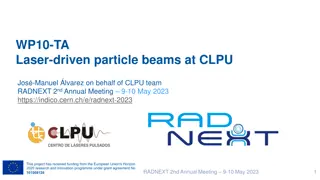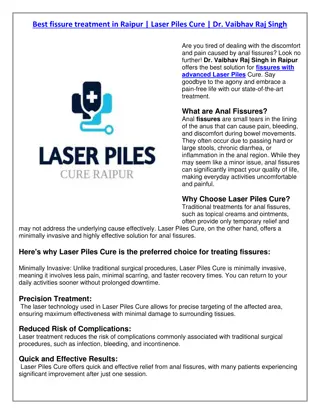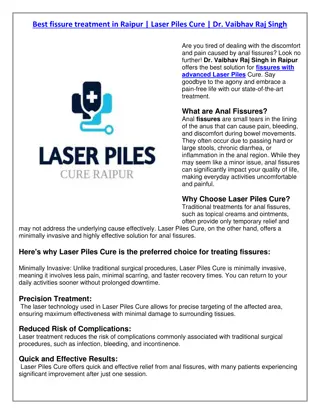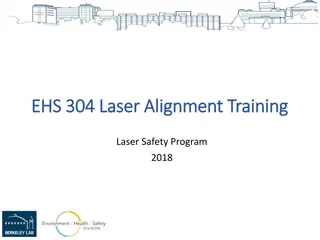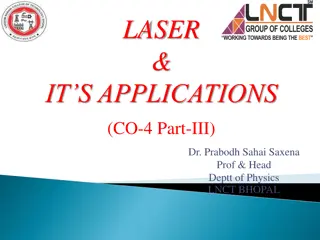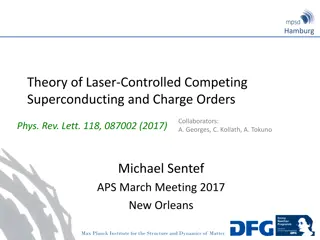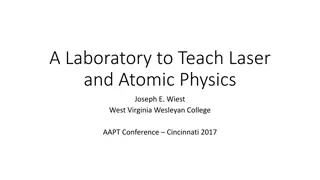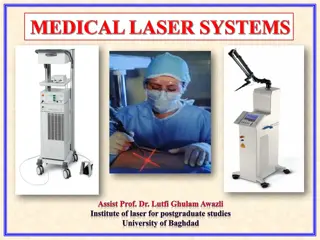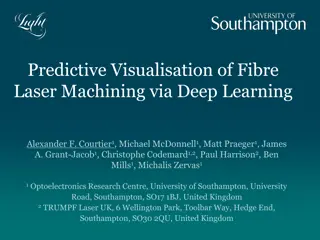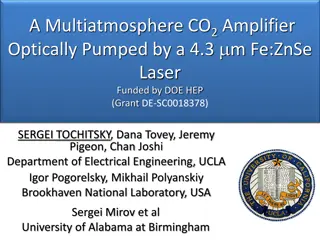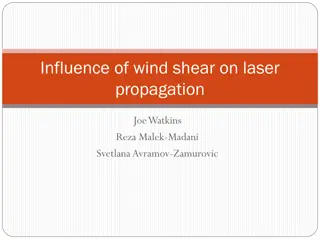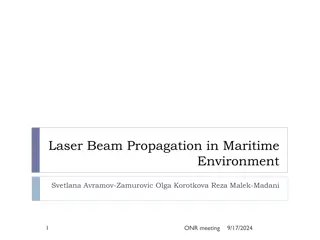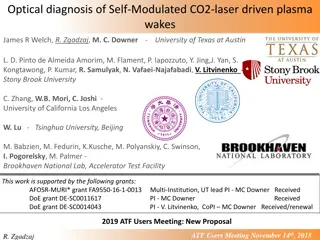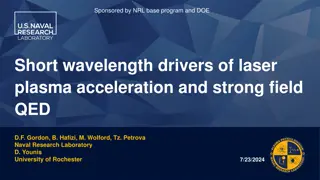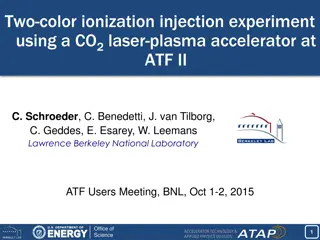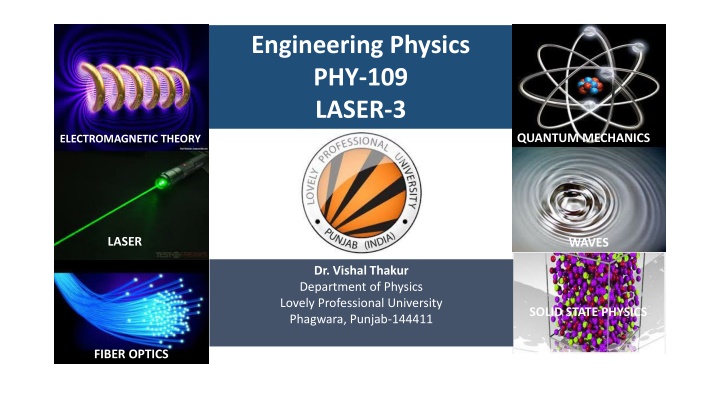
Principles of Laser and Lasing Action Explained
Learn about the fundamentals of laser technology, including the energy levels in atoms, radiation-matter interaction, population inversion, and lasing action. Discover how lasers work through processes such as optical pumping and stimulated emission, essential for various applications in engineering and holography.
Download Presentation

Please find below an Image/Link to download the presentation.
The content on the website is provided AS IS for your information and personal use only. It may not be sold, licensed, or shared on other websites without obtaining consent from the author. If you encounter any issues during the download, it is possible that the publisher has removed the file from their server.
You are allowed to download the files provided on this website for personal or commercial use, subject to the condition that they are used lawfully. All files are the property of their respective owners.
The content on the website is provided AS IS for your information and personal use only. It may not be sold, licensed, or shared on other websites without obtaining consent from the author.
E N D
Presentation Transcript
Engineering Physics PHY-109 LASER-3 QUANTUM MECHANICS ELECTROMAGNETIC THEORY LASER WAVES Dr. Vishal Thakur Department of Physics Lovely Professional University Phagwara, Punjab-144411 SOLID STATE PHYSICS FIBER OPTICS
Syllabus Fundamentals of laser- energy levels in atoms Radiation matter interaction, Absorption of light Spontaneous emission of light, stimulated emission of light Population of energy levels, Einstein A and B coefficients Metastable state, population inversion, lasing action Properties of laser, resonant cavity, excitation mechanisms Nd - YAG, He-Ne Laser, Semiconductor Laser Applications of laser in engineering, holography.
Principle of Laser For lasing action there should be more number of atoms in the metastable state than in the ground state. The achievement of this condition gives rise to more stimulated emission. Full lasing action is done in the following four steps. 4 3 2 1 Excited State Excited State Excited State Excited State E2 E2 E2 E2 ? ? E1 E1 E1 E1 Optical Pumping Metastable State Metastable State Metastable State Metastable State ? ? E0 E0 E0 E0 Ground State Ground State Ground State Ground State
Principle of Laser Step-1: Atoms in the ground state are pumped to the excited state E2 by photons of energy ? = ?2 ?1. ? is the frequency of the incident radiation and E2 and E0 are the energy of the excited state and ground state respectively. Step-2: From the excited state E2, the atoms make a rapid transition to the metastable state E1. The energy is released in photons of frequency ? where, ? = ?2 ?1. Step-3: The metastable states are occupied by many atoms from the upper excited state. The condition of population inversion is achieved thereby. Step-4: An incident photon stimulates the atoms in the metastable state, to come down to the ground state by emitting the stimulated emission. The emitted photons have the same frequency as the original photon.
Requirement of three level system Optical pumping will at most only achieve equal population of a two-level system. This is because the probabilities for raising an electron to the upper level and inducing the decay of an electron to the lower level (stimulated emission) are exactly the same! In other words, when both levels are equally populated, the numbers of electrons "going up" and "down" will be the same, so you cannot achieve population inversion which is required for lasers. The solution is to use a third metastable level. The pumping will be between the other two, but electrons in the upper energy level will quickly decay into the metastable level, leaving the upper level practically unpopulated at all times. The transition from the metastable level to the ground level has a different frequency: the laser frequency. The pumping frequency is between upper level and the ground level, so the pumping is off-resonant to the laser transition and will, thus, not trigger stimulated emission. https://physics.stackexchange.com/questions/72080/lasing-in-a-2-level-system
Non Radiative Transition Atoms and ions, such as laser-active ion in laser gain media, have various excited energy levels. Transitions of such atoms and ions to lower-lying levels are often associated with the emission of photons (light). The generated photons carry with them the difference of energy between the involved energy levels. However, there are also mechanisms which allow for non- radiative transitions (or nonradiative or radiation less transitions), i.e., transitions not involving light. The excess energy is then dissipated in some other way in most cases, in the form of phonons, which are associated with lattice vibrations of a solid. In liquids, similar phenomena can occur, but hardly in gases, where the atoms or molecules are not in contact with others for most of the time and therefore hardly have a chance to dissipate excitation energy non-radiatively. Phonon emission is a very rapid process in solids in cases where the transition energy is smaller than the energy of some of the phonons of the lattice. The radiative transition is then effectively bypassed and cannot be observed. For larger transition energies, only multi-phonon transitions are possible, where one transition involves the emission of multiple phonons. The rate of such processes becomes rather small when more than about three phonons need to be emitted. https://www.rp-photonics.com/non_radiative_transitions.html
Three level Vs. Four Level Pumping Scheme Three level Four Level In a three-level system, the laser transition ends on the ground state. Here, the lower lasing level is well above the ground state (separation more than ??) and is quickly depopulated e.g. by multi-phonon transitions. Lasing action happens between the metastable state and the ground state. Lasing action happens between the metastable state and the state above the ground state. Photons of energy h? = ?3 ?1 are absorbed which excite the atom to level E3. After that some atoms come down to the state E2 mostly through non-radiative spontaneous transitions and others come down to the ground state. Since the terminal level (E2) is almost vacant, population inversion between E3 and E2 is quickly established. A photon of energy ? = ?3 ?2 (due to spontaneous emission) can initiate a chain of stimulated emission. Three level energy diagram Condition of population inversion at the level E2 triggers stimulated emission. The atoms in E2 reach ground state by radiative or non radiative transition and are available for excitation once again. For better pumping efficiency the metastable state should be a band of energies rather than a single line so that more atoms can be accommodated. Atoms become immediately ready for re- excitation. This is because lifetime of E2 is short and atoms quickly drop down to the ground state. Requires high pumping power and this is a disadvantage. Very less pumping power is required as lower lasing level is nearly empty. Four level energy diagram
LASER: Main components 1. Energy source/pumping: To raise the system to an excited state and to achieve a state of population inversion. 1. Active medium: A system in which a state of population inversion is to be achieved is called an active medium or gain medium. It may be a solid, liquid or gas. 2. Optical resonator: Consists of two mirror facing each other. The active medium is enclosed by this cavity. One of the mirror is fully reflective and the other is partially transparent. It is used to make stimulated emission possible in more number of atoms in the active medium. This naturally increases the intensity of the laser beam.
Action of optical resonator Initially the active centers are in ground state and the medium is in non excited state. By suitable pumping scheme the material is taken into a state of population inversion. Spontaneous photons are emitted in all direction in the initial stage. To generate a coherent output, photons of a specific direction are selected while others are rejected. To attain maximum possible amplification of light, the stimulated photons are to be made to pass through the medium a number of times. The mirrors constituting the resonator cause the directional selectivity. Photons that travel in random direction will pass through the resonator and are lost. The semi-transparent mirror allows some photons to pass through and others are reflected back. Some photons are absorbed at the fully reflecting mirror but majority will be reflected. The beam is amplified/gain in strength after suffering multiple reflections along the path.
Action of optical resonator Wavenumber: Describes how many oscillations it completes per unit of space. the wavenumber (also wave number) is the spatial frequency of a wave, either in cycles per unit distance or radians per unit distance. It can be envisaged as the number of waves that exist over a specified distance (analogous to frequency being the number of cycles or radians per unit time). ? =2? K=phase change per unit length. 2 nodes in 4 units of length. ? =2 Again ? = 2?/? Thus,2? 2? Or, ? = 4 4? =1 2? ?=1 ? https://en.wikipedia.org/wiki/Wavenumber https://en.wikipedia.org/wiki/Wavenumber https://www.quora.com/What-is-the-meaning-of-wave-vector-k https://www.quora.com/What-is-the-meaning-of-wave-vector-k Now, if a wave is travelling to and fro in the resonator cavity, then the total phase change suffered by the wave in one complete round trip must be an integral multiple of 2?. Hence, if ? is the length of the cavity, then ????? ? ??? ? ???? = 2??,? = 1,2,3 . 2? ? ? =?? 2? = 2?? 2

